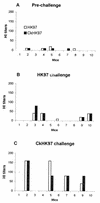DNA vaccine encoding hemagglutinin provides protective immunity against H5N1 influenza virus infection in mice
- PMID: 9971791
- PMCID: PMC104453
- DOI: 10.1128/JVI.73.3.2094-2098.1999
DNA vaccine encoding hemagglutinin provides protective immunity against H5N1 influenza virus infection in mice
Abstract
In Hong Kong in 1997, a highly lethal H5N1 avian influenza virus was apparently transmitted directly from chickens to humans with no intermediate mammalian host and caused 18 confirmed infections and six deaths. Strategies must be developed to deal with this virus if it should reappear, and prospective vaccines must be developed to anticipate a future pandemic. We have determined that unadapted H5N1 viruses are pathogenic in mice, which provides a well-defined mammalian system for immunological studies of lethal avian influenza virus infection. We report that a DNA vaccine encoding hemagglutinin from the index human influenza isolate A/HK/156/97 provides immunity against H5N1 infection of mice. This immunity was induced against both the homologous A/HK/156/97 (H5N1) virus, which has no glycosylation site at residue 154, and chicken isolate A/Ck/HK/258/97 (H5N1), which does have a glycosylation site at residue 154. The mouse model system should allow rapid evaluation of the vaccine's protective efficacy in a mammalian host. In our previous study using an avian model, DNA encoding hemagglutinin conferred protection against challenge with antigenic variants that differed from the primary antigen by 11 to 13% in the HA1 region. However, in our current study we found that a DNA vaccine encoding the hemagglutinin from A/Ty/Ir/1/83 (H5N8), which differs from A/HK/156/97 (H5N1) by 12% in HA1, prevented death but not H5N1 infection in mice. Therefore, a DNA vaccine made with a heterologous H5 strain did not prevent infection by H5N1 avian influenza viruses in mice but was useful in preventing death.
Figures


References
-
- Beare A S, Webster R G. Replication of avian viruses in humans. Arch Virol. 1990;119:37–42. - PubMed
-
- Centers for Disease Control and Prevention. Update: isolation of avian influenza A(H5N1) viruses for humans—Hong Kong, 1997–1998. Morbid Mortal Weekly Rep. 1998;46:1245–1247. - PubMed
-
- Claas E C, Osterhaus A D M E, van Beek R, De Jong J C, Rimmelzwaan G F, Senne D A, Krauss S, Shortridge K F, Webster R G. Human influenza A(H5N1) virus related to a highly pathogenic avian influenza virus. Lancet. 1998;351:472–477. - PubMed
-
- Cohen J. The flu pandemic that might have been. Science. 1997;277:1600–1601. - PubMed
Publication types
MeSH terms
Substances
Grants and funding
LinkOut - more resources
Full Text Sources
Other Literature Sources
Medical
Research Materials

